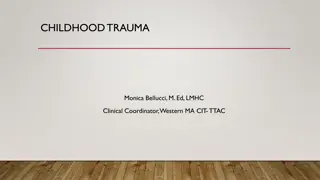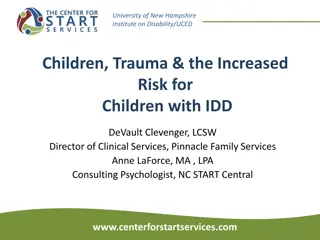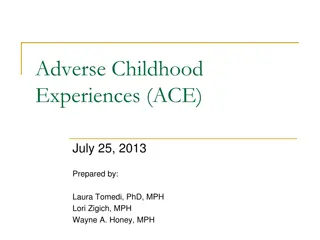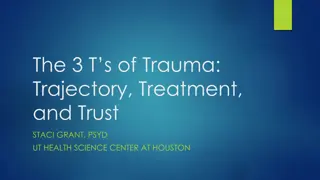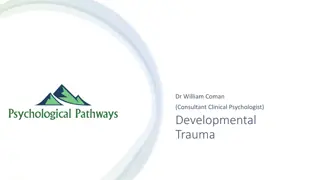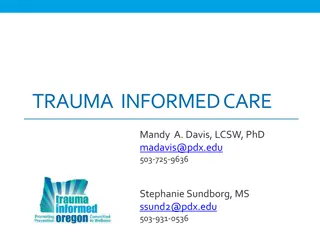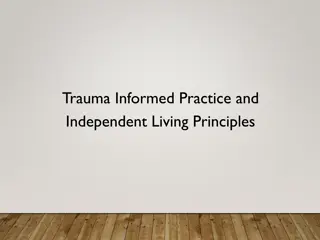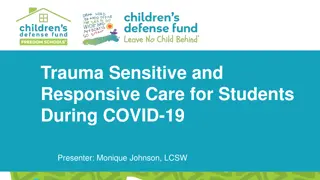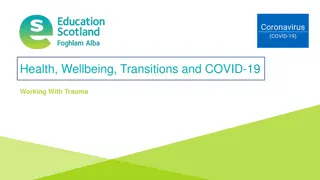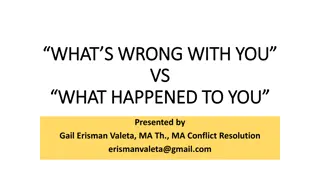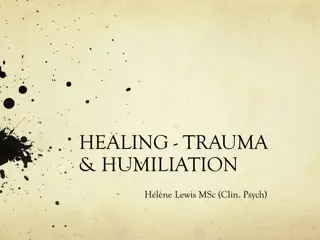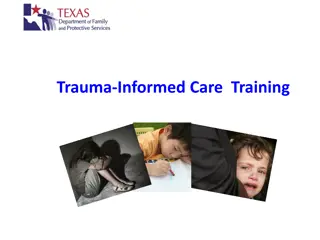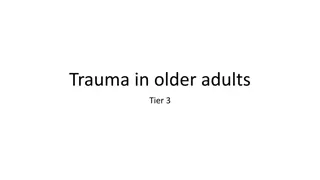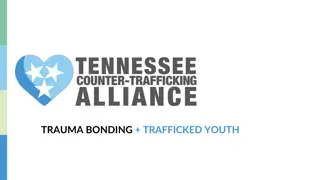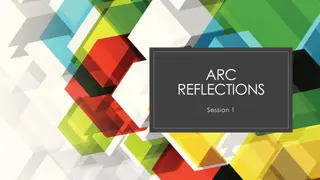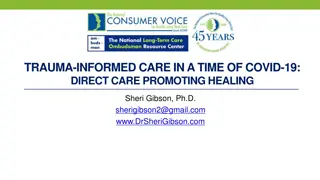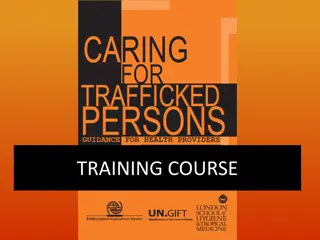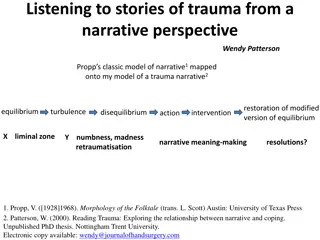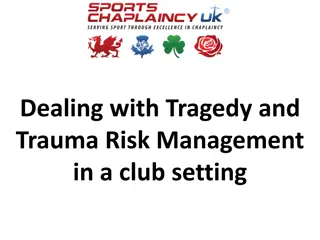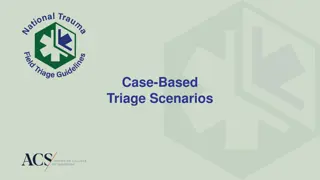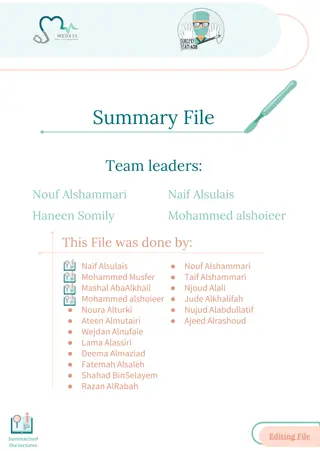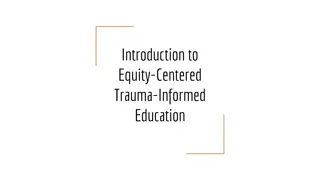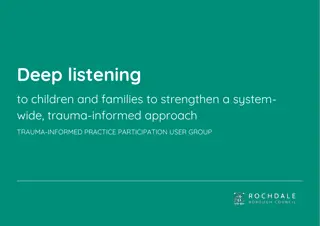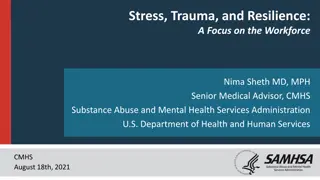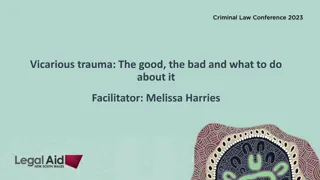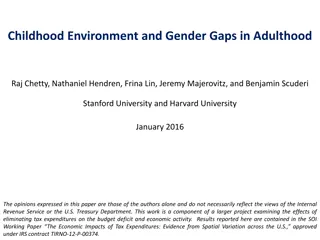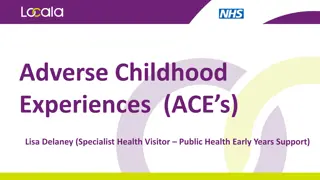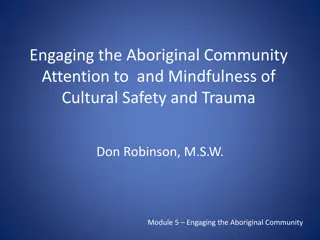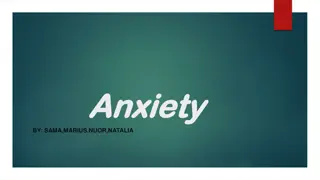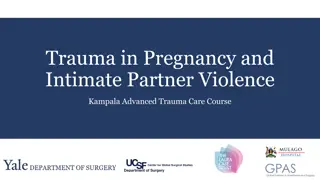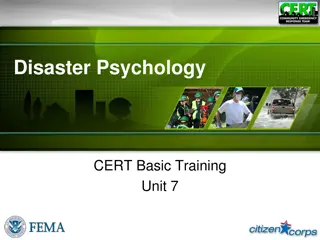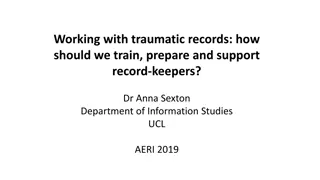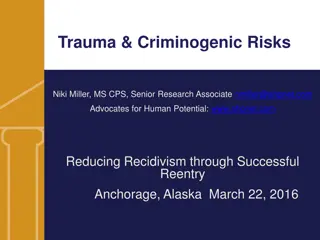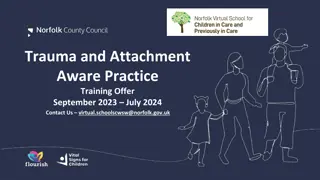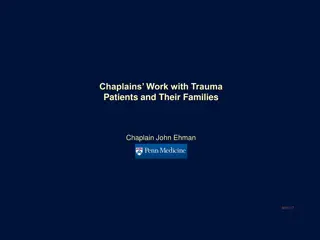Understanding Childhood Trauma and Its Effects
Explore the impact of childhood trauma on individuals' development and well-being. Learn about identifying trauma, types of abuse, and how to address it in a trauma-informed way. Discover the importance of building strong children to prevent long-term consequences.
Download Presentation

Please find below an Image/Link to download the presentation.
The content on the website is provided AS IS for your information and personal use only. It may not be sold, licensed, or shared on other websites without obtaining consent from the author. Download presentation by click this link. If you encounter any issues during the download, it is possible that the publisher has removed the file from their server.
E N D
Presentation Transcript
CHILDHOOD TRAUMA Monica Bellucci, M. Ed, LMHC Clinical Coordinator, Western MA CIT-TTAC
CHILDHOOD TRAUMA It is easier to build strong children than to repair broken men -Fredrick Douglas
LEARNING OBJECTIVES Participants will be able to identify childhood trauma and abuse and how that affects the child s developing brain Participants will gain knowledge on ACE s (Adverse Childhood Experiences) and how it impacts all areas of functioning throughout a persons life span (medical, social, psychological, and criminal justice) and puts individual s at a greater risk for justice system involvement. Participants will be able to better understand attention deficit hyper activity disorder and identify how it can present in youths with trauma Participants will be able to describe methods law enforcement can use to interact with youths in a trauma informed way.
WHAT ARE SOME EXAMPLES OF POSSIBLE CHILDHOOD TRAUMA Divorce Bulling Abuse (sexual, physical, emotional, verbal) Parental/Caregiver MH/SA Parental/Caregiver incarceration Neglect Multiple foster homes Poverty Exposure to violence Exposure to sexual experiences `
TYPES OF ABUSE TYPICALLY OCCURRED IN CHILDHOOD Physical abuse Sexual abuse Emotional/mental abuse Neglect
WHAT HUMANS NEED FOR BIOLOGICAL (SPECIES) SURVIVAL Food Water Shelter Sex Attachment
ATTACHMENT HARRY HARLOW MONKEY EXPERIMENT https://youtu.be/9wmvZH5lX_U
NEGLECT STILL FACE EXPERIMENT https://youtu.be/FaiXi8KyzOQ?si=KAv-LUZH6HwZSo13
THE NEOCORTEX (REVIEW) The cerebral cortex, the frontal cortex, is the front structure of our brain. It contains most of our language abilities. This hemisphere of the brain processes information in an explicit, logical, analytical, and linear fashion. It s important for our functioning in a health lifestyle, that everything is integrated and linked. This part of the brain is not fully developed until around age 25
TRAUMA AND THE CHILD BRAIN https://www.tiktok.com/@docamen/video/7264267732814777643?is_from_webapp=1&s ender_device=pc&web_id=7304316798345905710
ADVERSE CHILDHOOD EXPERIENCES (ACES) QUESTIONNAIRE Section 1 A household member swore at, insulted, humiliated, or put you down in a way that scared you OR a household member acted in a way that made you afraid that you might be physically hurt Someone touched your private parts or asked you to touch their private parts in a sexual way that was unwanted, against your will, or made you feel uncomfortable More than once, you went without food, clothing, a place to live, or had no one to protect you Someone pushed, grabbed, slapped or threw something at you OR you were hit so hard that you were injured or had marks You lived with someone who had a problem with drinking or using drugs You often felt unsupported, unloved and/or unprotected
ADVERSE CHILDHOOD EXPERIENCES (ACES) QUESTIONNAIRE CONT Section 2. At any point since you were born You have been in foster care You have experienced harassment or bullying at school You have lived with a parent or guardian who died You have been separated from your primary caregiver through deportation or immigration
ADVERSE CHILDHOOD EXPERIENCES (ACES) QUESTIONNAIRE CONT You have had a serious medical procedure or life threatening illness You have often seen or heard violence in the neighborhood or in your school neighborhood You have been detained, arrested or incarcerated You have often been treated badly because of race, sexual orientation, place of birth, disability or religion You have experienced verbal or physical abuse or threats from a romantic partner (i.e. boyfriend or girlfriend)
ACES https://youtu.be/95ovIJ3dsNk?si=-5UnaWhcr4zAzS7Y
HOW THE BRAIN REACTS TO REPEATED TRAUMA The development and functioning of the three parts of the brain rely heavily on our childhood experiences. This includes early attachment figures, conditions in our environment, and traumas. If we have ongoing or repeated threats in life, or on-going emotional/physical neglect, our brains become hypersensitive to cues that remind us of those traumatic experiences. We can then have intense emotional reactions to cues, and our reptilian brain will then automatically activate our survival/trauma response system Significant number of adults with Mental Health and Substance Use (at least 50%), their origin story is Adverse Childhood Experiences
ATTENTION DEFICIT HYPER ACTIVITY (ADAH) https://www.instagram.com/reel/Cvc-UjVtIVO/?igshid=MzRlODBiNWFlZA==
WHAT IS ATTENTION HYPER ACTIVITY DISORDER (ADHD) ADHD affects the prefrontal cortex, the human part of our brains responsible for executive functioning ADHD also affects the mammalian part of our brains which regulates emotions memory and behaviors. Often fidgets with or taps hands, feet, squirms in seat Often leaves seat in situations when remaining seated is expected Often runs about or calm in situations where it is inappropriate Often unable to unable to play or engage in leisure activities quietly Often on the go acting as if driven by a motor
ADHD Often talks excessively Often blurts out an answer before a question has been completed Often has difficulty waiting their turn Often interrupts on intrudes on others (butts into conversations, games, activities)
ACTIVITY Blinking/Story telling
TRAUMA AND CHILDHOOD BRAIN DEVELOPMENT https://www.tiktok.com/@mindbrainbodylab/video/7138822535709232426?is_from_web app=1&sender_device=pc&web_id=7304316798345905710
DIRECT VS INDIRECT MESSAGING Direct verbal communication. Direct verbal messaging processes through frontal lobe Indirect messaging is processed thought the emotional center and the brain stem. This is all the other types of communication, tone, body language, volume, facial expression etc When a person is experiencing a trauma response, they are operating primarily from their emotional center and brain stem.
SLOW SIMPLE REPEAT Slow Breathing Communication Simple KISS (keep it simple stupid ) Repeat Often in the same slow simple communication
REGULATE, RELATE, REASON Step 1: Regulate Breathing Walking Tapping Water Step 2: Relate Validate feelings (not behaviors) Identify wants, needs and feelings Use reflective language Step 3: Reason Talk about the specific topic
BOTTOM UP APPROACHES (COMMUNICATING TO THE NON VERBAL PART OF THE BRAIN) Breathing Water Soft tone of voice Soft posture Hearing and validation of emotions Sensory input or elimination grounding exercises- smells, tastes sights sounds touch Trauma stored in body and emotion center of brain Predictability, Safety, and Control
INCREASE BOTTOM UP INTERVENTIONS FOR CHILDREN (CONT) War heads (strong tasting) Playdough Muscle tension (wall sits, planks) Smells (essential oils on cotton swab) Playfulness/Humor
DECREASE TOP DOWN INTERVENTIONS (COMMUNICATING TO THE VERBAL PART OF THE BRAIN) Limit talking Increase silence Short declarative sentences Ask permission when ever you can Explain what you are doing or going to do or what will happen next
THANK YOU Questions???


